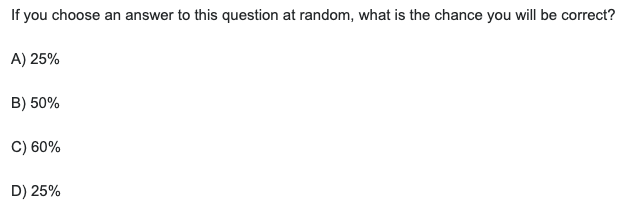A few years ago, I came across the following multiple choice question:

Argue about the solution all you’d like (oh, and people argue about the solution), the beautiful part of this, for me, is that the question is not really the question. The point of the exercise is not to complete the exercise, it’s to dwell a while in the complexities it offers. By constructing the argument, you interact with notions of odds, randomness, probability, and the like. This is similar to the idea of #SandwichChat, where the point is not to define what a sandwich actually is, but, rather, to play with emerging definitions and consider their consequences. I love these sorts of activities, because they, almost unexpectedly, turn our own thinking upon ourselves. They have a way of snapping us out from the familiar ebb and flow of the mathematics classroom, whereby prompts are passed to solvers who manufacture resolutions and, in turn, re-sell them back to teachers at increased costs. Teachers cover this inflation by remunerating the students with a most precious commodity–grades. And so the classroom economy ticks forward.1
Steeped in the routine of this economy, we enter into a question with the notion that we will simply recall an identical (or identical enough) situation and apply it to this new, evaluative device. In order to break this iteration, teachers must first convince students that an end goal (a resolution to the question) is not as important as the moments they spend puzzling along the way. After all, as an educator, I am less interested in how well-posed the problem seems to be, and more interested in the problems posed by those trying to make sense of the productive ambiguity. In short, you need to take the focus off of answering the questions. This is easier said than done, but one such way to do this is to not offer any questions at all.
Consider the following quiz:

I guess if we are going to get technical, this quiz has questions, but certainly not the variety that requires any sort of specialized mathematical understanding. My hope was that springing this unorthodox quiz on my students would create a feeling of comical unease. It is very unlikely to get seven Cs in a row, yet the occurrence was spelled out right in front of them. There is very little (aside from dutifully circling all the Cs) that a student can do to complete the quiz well. Their result feels completely tied up in chance–or in the possible foul play of the teacher. It then begs the question: What are the chances? Of course, this is the exact question I am attempting to dwell on as we study probability. The idea was to throw them headfirst into a probabilistic scenario in order to have them live in that tension for a moment. After about three minutes, I collected this first page and handed out a second:

These last three questions are designed to prompt an investigation to the first seven “questions” of the quiz. They are offered to prompt students to overlay their recent feelings of question 1-7 with the formalities of counting methods and classical probability. Mathematics is suggested as a way to dissect the feeling of uncertainty, and this act of justification becomes the focal point. I mean, of course it does. What is left to argue about the solutions of questions 1-7? They were simply the vehicle to encounter an experience, and, in this way, those seven “questions” were never the questions to begin with.
I wrote three of these “questionless” probability quizzes, and they can be downloaded here. They each create a scenario by asking a series of seven “questions”. The final few questions are designed to prompt reflection on said experience, to which permutations, permutations with repetition, the fundamental counting principle, combinations, probability with cases, etc. might offer some clarity. However, as nice as it is to chart a path toward a resolution, be aware that the ultimate point of eliminating the efficient stream from questions to answers in the first place was to create some space to dwell in the uncertainty, use math to make sense of it, and, ultimately, quantify those feelings of uncertainty. It is a subtle shift away from students working on probability questions and toward students working in probabilistic scenarios.
NatBanting